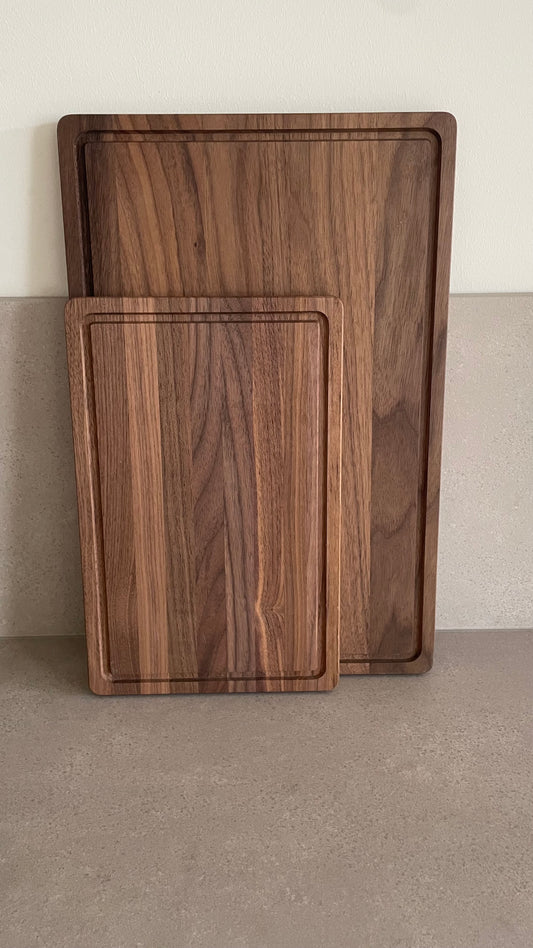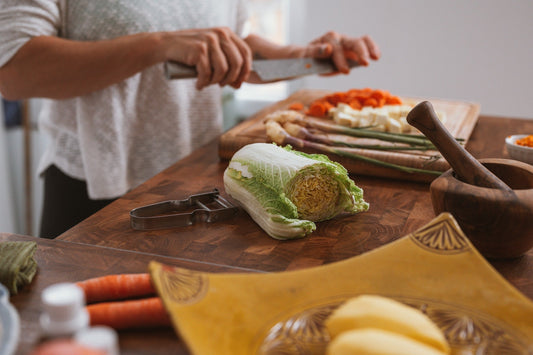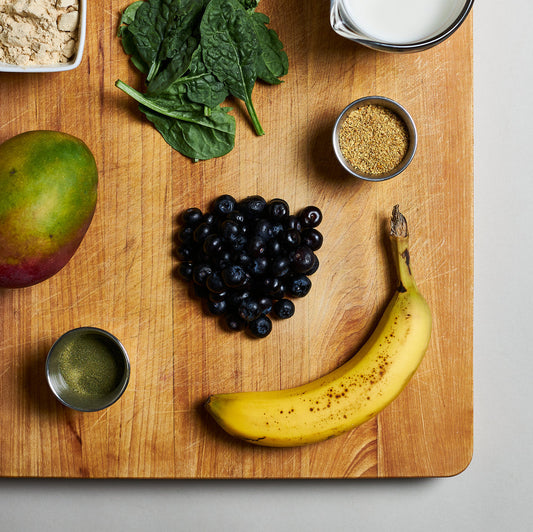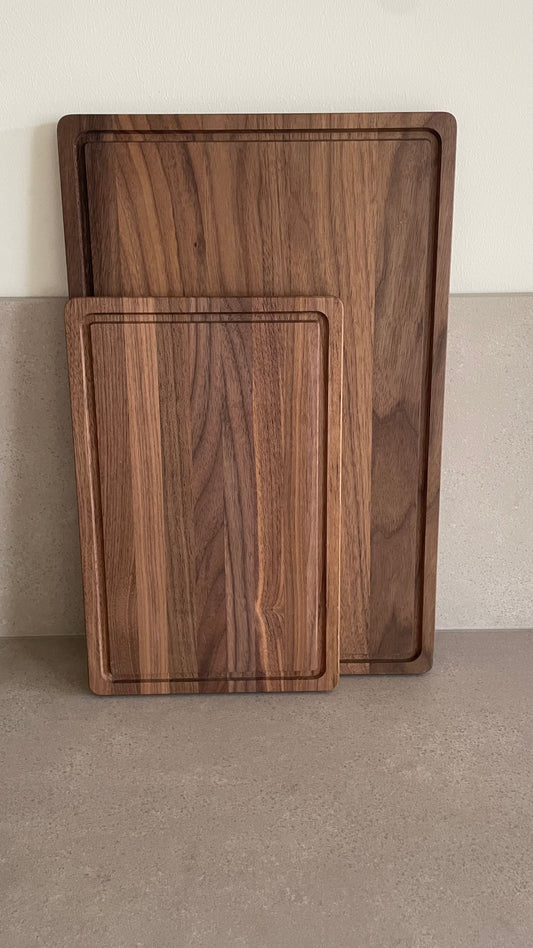After daily use: How to properly care for and clean wooden cutting boards
A cutting board is a basic item in every kitchen. Whether you're cutting vegetables, filleting fish, or chopping herbs, you can't do without it. Wooden cutting boards , such as beech or oak , are particularly popular with amateur chefs and professionals alike because they're durable, gentle on knife blades, and look great, too. To keep it that way, your wooden cutting board needs regular care.
But why exactly? Why isn't it enough to simply run the board under water for a short time and then put it away? And how exactly do you ensure that your wooden cutting board doesn't become brittle or become a bacteria trap? In this article, we'll show you everything you need to know: from daily cleaning to deep conditioning and regular oiling. With these tips, your cutting board will not only stay hygienic but will look like new even after years.
Why is caring for cutting boards so important?
Cutting boards come into contact with food every day. Especially with raw meat , fish, or juicy foods like tomatoes or fruit, liquids seep into the surface. This may be less of a problem with a plastic cutting board , but wood is a natural material. It absorbs and retains moisture. Despite its natural antibacterial properties , too much moisture and inadequate care can turn your cutting board into a breeding ground for germs.
Unmaintained wooden cutting boards can not only become unhygienic but also break more quickly. Without proper care , the wood will dry out, crack, and lose its natural resilience.
A well-maintained cutting board, on the other hand, is a faithful companion in the kitchen. It stays hygienic, looks better, and will last for years. The right combination of proper care , cleaning, drying, and oiling is key.
How to clean your wooden cutting board properly
Daily cleaning of your cutting board after use is essential to remove residue and bacteria. Wood has naturally antibacterial properties , but that doesn't mean you can skip a thorough cleaning. The process is really simple if you keep a few things in mind.
After use, you should first clean your cutting board of any large food residue. Use a spatula or a blunt knife to scrape off all residue. Make sure to clean the edges and grooves, too, as these are where tiny particles tend to collect.
Then clean your board with warm water and a little mild dish soap. A soft sponge or microfiber cloth is sufficient to thoroughly clean the surface. It's important to avoid using abrasive cleaners or harsh sponges. These can roughen the wood's surface and make it more susceptible to moisture.
Drying is a particularly important step. After cleaning, you should immediately dry your cutting board with a clean dishcloth. Never leave it wet on the countertop or put it in the dishwasher—the heat and water can damage the wood, causing it to warp or even crack. It's best to stand your board upright after drying so it can fully air out.
Deep cleaning for your cutting board
In addition to daily cleaning, you should give your cutting board a regular deep cleaning – especially if it has come into contact with raw meat or fish or has acquired unpleasant odors.
A natural and effective method is cleaning with salt and lemon. Sprinkle coarse salt on the surface of the board and rub it in with half a lemon. The salt removes residue and has an antibacterial effect, while the citric acid neutralizes unpleasant odors. After treatment, simply rinse the wooden board with clean water and dry it thoroughly.
Another alternative is vinegar and water. Mix white vinegar with an equal amount of water and wipe the surface with it. The vinegar has a disinfecting effect and is especially useful if the cutting board has been subjected to heavy use. Rinse the board with clean water afterwards to remove the vinegar smell.
Why you should oil your wooden cutting board
An often underestimated step in the care of wooden cutting boards is oiling. Many people don't realize how important it is to regularly treat the wood with oil. Oiling is crucial for the longevity of your cutting board.
The oil penetrates deep into the pores of the wood, ensuring the board remains supple. It prevents the wood from drying out, cracking, or warping. The oil also protects the surface from moisture. Water beads up on oiled wood, reducing moisture penetration into the material—making high-quality cutting boards more hygienic and durable.
Which oil is best for high-quality cutting boards ?
Not every oil is suitable for wooden cutting boards . Most importantly, the oil must be food-safe, as it will ultimately come into contact with your food.
The most popular choice is mineral oil. It's colorless and odorless, penetrates deeply into the wood, and won't go rancid. Mineral oil provides effective and safe care and is available at most kitchen supply stores.
If you prefer a natural alternative, you can use linseed oil or walnut oil. These oils are also food-safe, but they run the risk of becoming rancid over time.
You should avoid cooking oils such as olive or sunflower oil, as they quickly become rancid and can cause unpleasant odors.
Oiling a wooden cutting board: step-by-step instructions
- Preparation: Clean your cutting board thoroughly and let it dry completely. A damp board won't absorb the oil well.
- Apply oil: Drizzle some oil directly onto the surface of the board and spread it with a soft cloth or paper towel. Make sure to also coat the edges and back with oil.
- Allow to absorb : Allow the oil to absorb for at least 20 minutes. For extra intensive care, you can let the board rest overnight.
- Wipe off excess oil: Use a clean cloth to remove excess oil to prevent the surface from sticking
Repeat the process as needed, especially if the wood looks dry or rough. You can read everything you need to know about oiling cutting boards here !
Get the most out of your cutting board!
As you can see, it's not all that difficult. Just remember: A wooden cutting board is not only practical, but also a real gem in the kitchen. To ensure it remains hygienic and lasts for many years, proper cleaning and care are essential. Daily cleaning, thorough drying, and regular oiling are the three pillars that will keep your new cutting board in top shape right from the start.
With a little attention, your wooden cutting board will not only remain hygienic and durable, but will also look beautiful for years to come. So treat your kitchen helper with the care it deserves—you won't regret it!











